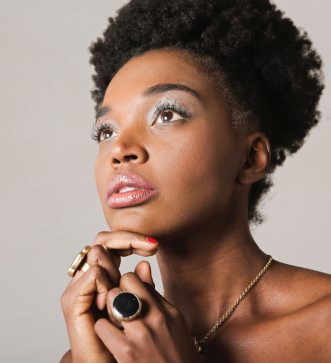
The 4 Basics for Healthy Natural Hair
If you are new to starting a healthy hair journey, you might not know where to begin. If you’re like me, you watched a ton of YouTube videos and read countless blogs trying to figure out what is the right way to take care of your hair. Unfortunately, there is no secret regimen or product that can provide you with healthy hair. It can be overwhelming at first and if you don’t know where to start you can end up buying a whole bunch of products that may not work with your hair and won’t see any progress. I wanted to share my tips on what I focused on that stopped me from wasting so much time and preventing frustration, leading me to a path to healthier hair.
- Moisture
Afro texture hair defies gravity but is also naturally dry. With dryness comes breakage which can prevent our hair from thriving to its full potential. Kinkier textures such as 4C hair is extremely fragile and manipulating dry brittle hair will cause unnecessary hair strands to end up in your comb or on the bathroom sink. Using products that contain water will keep your hair from drying out. You want to make sure that when you are using a product to moisturize your hair, one of the first ingredients would be WATER. A simple mix that you can use to your discretion is mixing a spray bottle with water and leave-in conditioner or aloe vera juice.
- Protein
Protein is just as important as moisture when it comes to maintaining healthy hair. Protein is essential when is come to the strength of our hair strands. Our hair is made up of mostly protein, approximately 91%. When we manipulate our hair by combing, brushing, and exposing it to harsh environments, we tend to leave gaps and spaces along our hair strands. Tighter coiled hair will naturally have gaps along the hair strand as our hair tends to twist and turn in every way. Using protein treatments will fill in the spaces and gaps, replacing the protein that was loss. Believe it or not, having a healthy balance of protein will help retain moisture in your hair.
- Deep Conditioning
Deep conditioning should always be a part of your regimen as just regular shampoo and conditioning is not enough. Your hair is like a sponge and when you just use rinse out conditioner, your hair is not taking in all the nutrients it needs to make it healthier. Using a deep conditioner for EVERY wash day will give it the extra boost it needs. Depending on what your hair needs you can use either a moisturizing or protein treatment for each wash day. You can deep condition your hair in many ways, using heat is more efficient and can help the conditioner penetrate the hair shaft. If you don’t have a hair dryer you can wrap a towel, a thick hat or a shirt over your shower cap and use body heat; just make sure to leave it in for at least 30 minutes.
- A Simple Regimen
When I first started my hair journey my regimen was way too complicated. I would use the baggy method on my hair every other night, co wash on a consistent basis, slab 5 or 6 different layers of products on my hair and then wonder why my hair growth was stunted and had so much product build up. The biggest thing I learned from my years being natural was to stop doing the most. And that was the hardest thing to overcome as I would spend HOURS on YouTube learning what other women would do to their hair to make it grow. Keep it simple, stick to something that you can be flexible with but still commit to. Washing and deep conditioning your hair every 1 to 2 weeks is a great place to start; with using methods such as the L.O.C or L.C.O method in between wash days to keep your hair moisturized.
There are couple of honorable mentions I want to speak on but will do so in a later post. Styling and nutrition have a role in healthy hair and if not done so correctly can lead to breakage, excessive shedding or hair loss. The main point is with all the information you receive here or anywhere, the best thing you can do is make sure that your regimen and what you use for your hair works for you. Following someone’s regimen to a tee might not be the best thing…. take it from someone who knows. It is a great place to start if you are a beginner but just make sure to make it into your own and listen to your hair. Focusing on these basics will result in healthier hair that you will notice in no time.





